Contents
Woodpeckers In Wisconsin
Embark on an enthralling expedition into the mesmerizing realm of Wisconsin’s woodpeckers! Meet nine charming species, each with its quirks and habits, from the majestic Pileated Woodpecker to the mysterious Yellow-bellied Sapsucker, uncovering the vibrant woodpecker community thriving in this northern-central state.
These lively feathered residents, celebrated for their rhythmic tree drumming near bedroom windows, are a familiar sight and melody across America. Their distinctive bills, aiding in skillful insect foraging beneath tree bark, have earned woodpeckers global recognition. Let’s delve into the unique personalities gracing Wisconsin, where the Badger State hosts nine distinctive woodpecker species, each adding its own charm to the natural symphony.
- Hairy Woodpecker
- Red-bellied Woodpecker
- Downy Woodpecker
- Red-headed Woodpecker
- Black-backed Woodpecker
- Pileated Woodpecker
- Northern Flicker
- Yellow-bellied Sapsucker
- American Three-Toed Woodpecker
Nestled in the heart of the north-central United States, Wisconsin warmly embraces nature enthusiasts with the awe-inspiring beauty of Lake Superior and Lake Michigan, two treasures among the Great Lakes. As the 23rd-largest state, Wisconsin’s vast woodlands and mixed woods serve as havens for a diverse woodpecker community.
These year-round residents, the eight charming woodpecker species, bring their own unique charm to Wisconsin’s natural symphony. While the Yellow-bellied Sapsucker, known for its elusive nature, briefly steps away, it adds an air of mystery. In the following sections, let’s explore the size, coloring, and distinctive traits that define each woodpecker’s personality, enhancing the enchantment of Wisconsin’s landscapes.
1. Hairy Woodpecker
Length: 7.1 – 10.1in
Weight: 1.4 – 3.4oz
Wingspan: 13.0 – 16.1in
Nestled in the enchanting woodlands of Wisconsin, Hairy Woodpeckers stand out with their larger bodies and bills, distinguishing them from their Downy counterparts. Picture their striking black and white striped heads, adorned with a subtle hint of red at the back, creating a unique avian spectacle. These year-round residents gracefully navigate the serene beauty of tall trees, steering clear of the bustling city scenes.

While Hairy Woodpeckers may make fewer appearances than their Downy kin, their presence is anything but ordinary. In the heart of Wisconsin’s woodlands, they bring a refined charm, sitting upright and watchful amidst their distinctive plumage. As they diligently search for insects on tree trunks and major branches, their natural grace adds a touch of elegance to the woodland landscapes.
2. Red-bellied Woodpecker
Length: 9.4in
Weight: 2.0 – 3.2oz
Wingspan: 13.0 – 16.5in
Encounter the Red-bellied Woodpecker all year round in Wisconsin, distinguished by its charming barred backs, soft plumage, and a fashionable red cap. Surprisingly, despite their name, the red belly of these woodpeckers isn’t always the star of the show. These social birds thrive in the eastern woodlands, where they enliven the scenery with lively interactions, pecking, and calling from the heart of towering trees. During the spring and summer months, the vibrant calls of Red-bellied Woodpeckers resonate loudly through the air.

Demonstrating distinctive characteristics, these woodpeckers exhibit a range of behaviors—exploring others’ nests, storing surplus food in tree hideouts, and participating in entertaining, unpredictable flights for both amusement and honing their aerial skills.
3. Downy Woodpecker
Length: 5.5 – 6.7in
Weight: 0.7 – 1.0oz
Wingspan: 9.8 – 11.8in
As previously said, Downy Woodpeckers resemble Hairy Woodpeckers in terms of color, although they are the smaller of the two. Throughout the year, these charming birds grace Wisconsin’s backyards, gardens, parks, and wooded retreats, becoming delightful year-round residents. Comparing this species to others Additionally, they have been seen flying around hummingbird feeders.
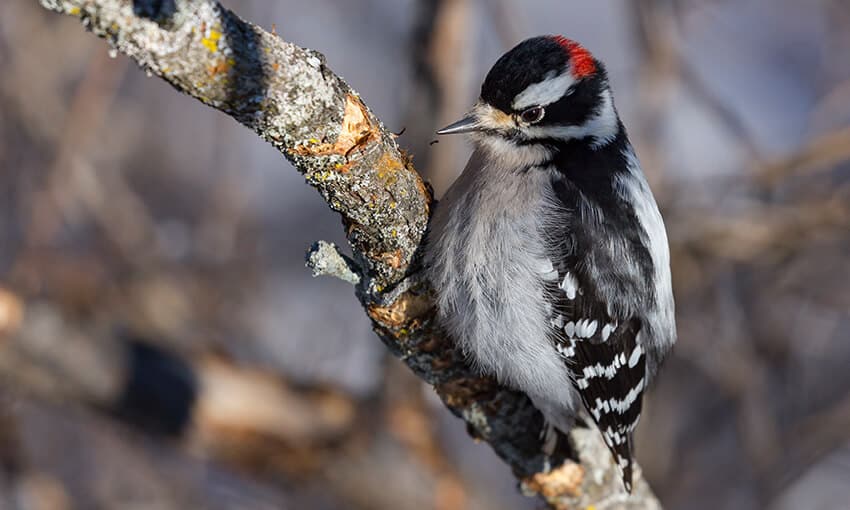
The Downy Woodpecker, with its blocky head and distinctive black and white plumage, prefers drumming on trees over singing, showcasing a unique communication style. Contrary to common belief, the tapping isn’t just about finding food; it’s their way of tapping out a tune and connecting with their surroundings. Interestingly, they employ the same rhythmic technique by picking at metal with their claws, adding a touch of percussion to their woodland symphony.
4. Red-headed Woodpecker
Length: 7.5 – 9.0in
Weight: 2.0 – 3.2oz
Wingspan: 16.5in
With their vivid redheads and striking black and white wings, red-headed woodpeckers are simple to identify. They’re frequently described as flying checkerboards. Sadly, during the past 50 years, their population has decreased. Red-headed woodpeckers like to nest and forage in open forested areas, close to decaying wood in marshes, or in pine-tree-dotted savannas.
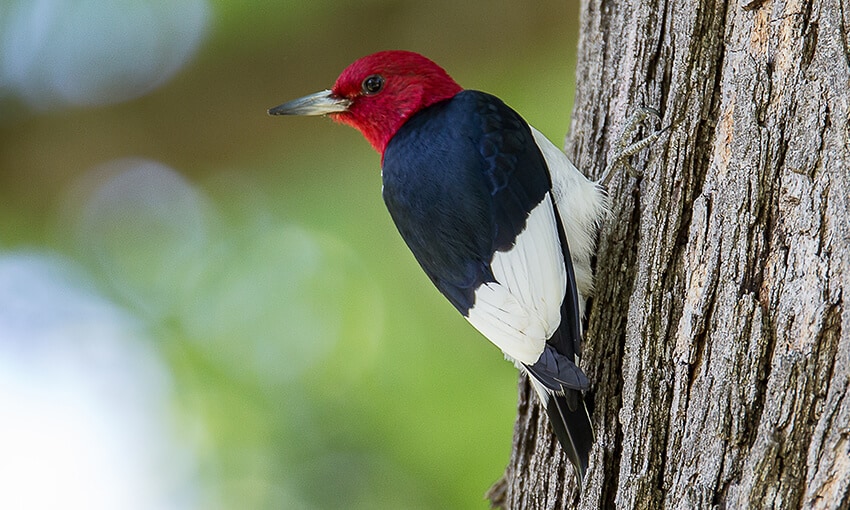
Known for their penchant for food storage, this woodpecker species shares similarities with the Red-bellied counterpart. In a unique twist, the Red-headed woodpecker elevates the practice by covering dried meals with wood or bark, a distinctive behavior seen in only four other woodpecker species.
5. Black-backed Woodpecker
Length: 9.1in
Weight: 2.1 – 3.0oz
Wingspan: 15.5 – 16.5in
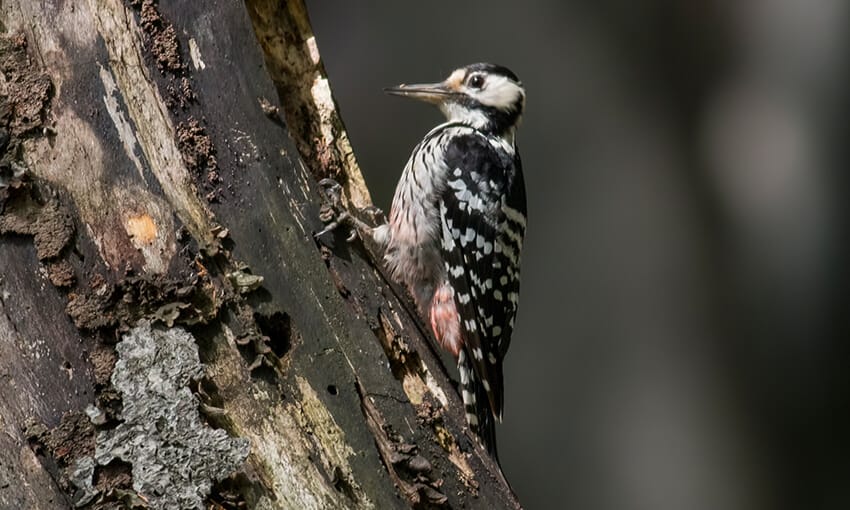
The Black-backed Woodpecker gets its name from the fact that it frequently inhabits burned woodlands. Due to their rich black plumage, they blend in perfectly with the burned wood. They are medium-sized, around the same size as the Hairy Woodpecker, with a white and grey underbelly and face. The bulk of Black-backed Woodpeckers is found in northern Wisconsin throughout the year, although they also wander up through Canada.
6. Pileated Woodpecker
Length: 15.8 – 19.3in
Weight: 8.6 – 12.3oz
Wingspan: 26.0 – 29.5in
Pileated Woodpeckers are year-round residents of Wisconsin and are the biggest and most easily recognized. This species, which is approaching the size of a common crow, is regarded as the largest woodpecker species in North America. Along with a vivid red crest, they have dazzling white spots on their head and chest.

The big, distinctive, oval-shaped holes that this woodpecker makes in trees are intriguing. In dead or downed, rotting trees, you can find them searching for carpenter ants. When they want a suet snack, they will wander into yards.
7. Northern Flicker
Length: 11.0 – 12.2in
Weight: 3.9 – 5.6oz
Wingspan: 16.5 – 20.1in
When compared to their rivals, the Northern Flicker’s coloring is particularly distinctive. Both the yellow-shafted and red-shafted varieties of this bird have dull, grayish-brown feathers with numerous little dark patches and markings on the underside.

In Wisconsin, you can frequently see these woodpeckers scrounging about in the dirt looking for food all year long. They enjoy exploring wooded areas and the margins of woods. The Northern Flicker uses its curved bill to burrow into the ground rather than pierce trees.
8. Yellow-bellied Sapsucker
Length: 7.1 – 8.7in
Weight: 1.5 – 1.9oz
Wingspan: 13.4 – 15.8in
Yellow-bellied Sapsuckers are undoubtedly sap-sucking woodpeckers, as suggested by their name. This woodpecker lives in deciduous woodlands and uses shallow holes and sap to catch insects. When eating, they leave behind neatly rowed sap wells.
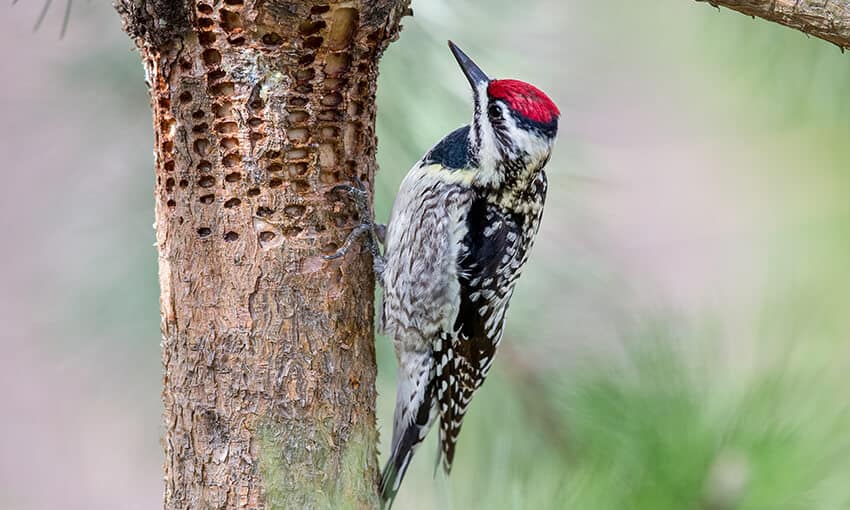
There are two types of holes they can make: round or rectangular. As was already noted, the round holes are deep and employed for sap probing, whilst the shallow holes help to reach sap and capture insects. Only seen in Wisconsin during the breeding season, these birds are black and white with red patterns on their caps. Their throat patches are red on the males, and their undersides are yellow.
9. American Three-Toed Woodpeckers.
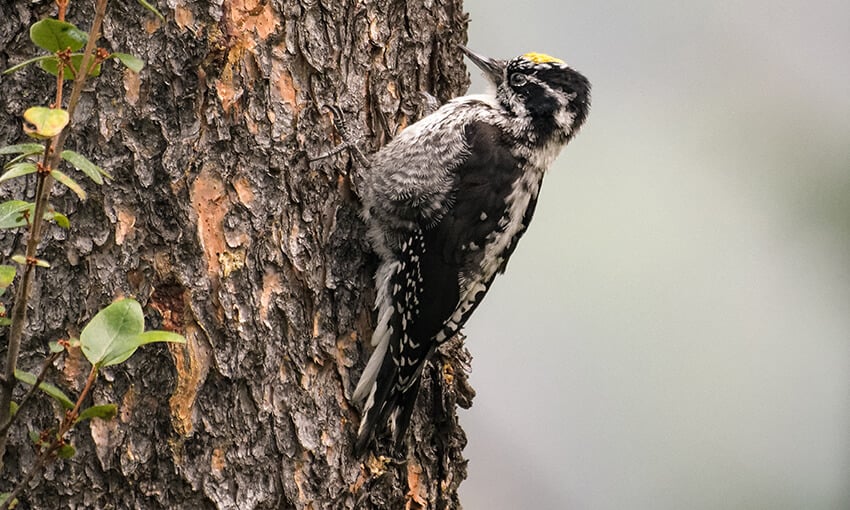
Woodpeckers: Is Attracting Them a Good Idea?
Nothing beats waking up on a gorgeous spring morning to the jackhammering of a woodpecker, as we said at the beginning. Even though birds are beautiful to look at and intriguing to watch, it is best to avoid letting them into your yard. Home damage from woodpeckers can cost tens of thousands of dollars. Learn more about woodpecker damage indicators and how to prevent them from settling on your property by reading the information below.
Signs of Woodpecker Damage
They are pests because of their habit, despite the fact that it is interesting. Various surfaces, including wood and stucco, can sustain damage from a woodpecker’s repeated drilling. Rows or columns of small to medium-sized, deep, or shallow holes are typical woodpecker damage. Even bigger nesting holes could be visible. Because they constantly make their holes audibly, woodpeckers can always be distinguished from insects. In contrast to other birds, woodpeckers will look for food or shelter close to metal gutters or chimneys in order to tap angrily to mark and defend their area.
When attempting to convince a woodpecker to go, it is essential to avoid hurting or killing it. Like all birds, woodpeckers play a crucial role in ecology. Despite not migrating, they are protected in the United States under the Migratory Bird Act of 1918. Read on to discover how to keep them out of your yard.
Three Ways to Get Rid of Woodpeckers
Remove or Change the Food Source
Since insects are a woodpecker’s main source of food, getting rid of infestations will be crucial. Check for termites, beehives, and any fallen or rotting trees. You can either treat your yard or hire a specialist to get rid of any unwelcome pests that might entice woodpeckers. Get any dead trees removed from your property if you want to keep woodpeckers away.
Even if you take the aforementioned precautions, woodpeckers might still frequent your yard. Another option is to give them something else to eat. Suet, a food produced from cow fat, is a favorite food of woodpeckers. In the late fall, winter, and early spring, they frequently throng to this.
Place the feeder close to where the woodpeckers are. Move the feeder gradually further from the starting location as the days go by. When summertime arrives, take the feeder entirely down. The woodpeckers will be able to realize that there are no trees or food sources nearby thanks to this.
If there is room, growing fruit or berry trees can be tried as another food source. Fruits and berries are favorites of woodpeckers and will keep them away from houses while also giving them food and a place to hang out.
Frighten Them Away
Similar to other birds, woodpeckers can be startled by things that emit light or generate noise. Think of using wind chimes, vintage CDs, pinwheels, or metal pie pans as tree decorations. Using reflective tape on trees can help deter woodpeckers. Long strips of tape can be hung from the branches of the trees, where they will blow in the wind and reflect light. It should be noted that, depending on the weather in your area, the tape will need to be changed periodically.
Decoy owls are another deterrent that can be placed in a tree to keep woodpeckers away. Owls are predators of woodpeckers, and they will feel threatened. However, it is important to move the owl regularly. Woodpeckers are smart, and leaving an owl in one place for too long will prove that it is of no harm to them. Sometimes even after moving the owl from tree to tree, homeowners have reported that it can become ineffective.
Prevent Woodpeckers from Returning
A more long-lasting approach to deter woodpeckers from coming back is with bird netting. The surface, which is being harmed, is hung about 3 to 4 inches from the mesh netting. The woodpeckers will be physically discouraged from trying to hammer at the surface by this netting. The neighboring trees can also be shielded with this netting. Unfortunately, depending on how much netting you need, this approach takes time and may be pricey. This approach is one of the least obvious, like the owl.
We hope the above tutorial has expanded your knowledge of the eight woodpeckers in Wisconsin species, as well as how to spot and avoid damage to your home and property.
[…] Woodpecker is not pet bird but if you want to keep them in your forests then you must arrange for various types of insects for their livelihood. […]